#franz kirchner
Explore tagged Tumblr posts
Text

Synopsis:
Lana is a super feisty, forward-thinking, and passionate 12-year-old girl, and the heir to her father’s adventuring ship, the Mighty Windbreaker. Along with her Viking dad and his diverse crew of rogues (a dwarf, an orc, a barbarian, and a cyclops), she sails across the Ten Realms, dreaming of becoming one of the greatest adventurers of all time. But first, she must overcome some challenging obstacles: impulsivity, stubbornness, extreme curiosity, disdain for rules, and love of pancakes. All the best things about her!
9 notes
·
View notes
Text










Wat? Der Schimmel ‘Gazelle’ (1881) door Henri de Toulouse-Lautrec, Blaues Pferd II (1911) door Franz Marc, Der Nachtschwärmer (1920) door Marianne von Werefkin, Krähenlandschaft ( 1925) door Paul Klee, Kühe bei Sonnenuntergang (ca. 1918-1919) door Ernst Ludwig Kirchner, Zwei Mädchen mit Pudel (ca. 1924-1925) door Otto Mueller, Der Pfau (1912) en Die blaue Kuh (ca. 1911) door Nathalia Goncharova, Vögel und Insekten (1938) door Joan Miró en Rotes Pferd (1966) door Alexander Calder
Waar? Die Sammlung Batliner in Albertina, Wenen
Wanneer? 10 maart 2025
Op 8 juni 2019 overleed kunstverzamelaar Herbert Batliner op negentigjarige leeftijd. De advocaat uit Liechtenstein liet zijn omvangrijke en zeer waardevolle kunstcollectie na aan het Albertina in Wenen. De werken die Batliner vanaf de jaren vijftig verzamelde geven een goed beeld van de belangrijkste kunststromingen van eind-negentiende en twintigste eeuw.
Als ik denk aan kunstenaar Henri de Toulouse-Lautrec, dan denk ik aan vrouwen, theater en vertier. Ik denk zeker niet aan paarden. Dat blijkt een omissie. Als gevolg van een lang ziekbed vanwege een gecompliceerde beenbreuk, die uiteindelijk zou leiden tot de vervorming van zijn benen, begon Henri al vroeg te tekenen. Zijn vader had een passie voor jagen en paardrijden. Henri kreeg zijn eerste schilderlessen van René Princeteau, een vriend van de familie en dierenschilder. Het is dus niet verwonderlijk dat Henri aanvankelijk vooral honden en paarden tekent en schilderde. Het paard Gazelle behoorde tot de stal van de familie van Henri’s moeder. Toulouse-Lautrec was zestien toen hij het paard schilderde.
‘Doorgaand op het thema ‘Paarden’ komen we bij een werk van Franz Marc. De schilder paste niet langer realistische kleuren toe, maar ging gebruik maken van een expressionistisch kleurenpallet. Het symbolisme van kleuren was daarbij heel belangrijk voor Marc. In 1910 schreef hij aan August Macke dat hij blauw beschouwde als het ‘mannelijk principe’: ‘ruw en spiritueel’. Vanaf 1910 schilderde Marc met name nog dieren, die hij beschouwde als symbolen van ‘puurheid van de ziel’. Deze behoort tot een andere werkelijkheid dan die der mensen.
Marc was, samen met Kandinsky, grondlegger van Der Blaue Reiter, een in München opgerichte avant-garde kunstbeweging, waartoe ook Von Jawlensky, Macke, Münter, Klee, Von Werefkin en Feininger behoorden. Al deze schilders zijn in het Albertina te zien. Aangezien ik in dit stukje voor de dierenwereld heb gekozen, noem ik als voorbeeld Der Nachtschwärmer van Marianne von Werfkin, waarin een wolf (?) ’s nachts door het bos sluipt. Maar ook Paul Klee kan aan de collectie worden toegevoegd met Krähenlandschaft.
Terwijl in München Der Blaue Reiter ontstond, richtten in Dresden een aantal jonge kunstenaars kunstgroep Die Brücke op. Een van de prominente leden was Ernst Ludwig Kirchner. Toen hij zich na psychische problemen in de Alpen vestigde, schilderde hij daar Kühe bei Sonnenuntergang.
Een van mijn favoriete Duitse expressionisten is Otto Mueller. Zijn slanke naakten zijn altijd onmiddellijk herkenbaar. Naakten zijn weliswaar niet het onderwerp van deze bijdrage aan mijn kunstdagboek, maar gelukkig staat er op het in het Albertina getoonde werk (Zwei Mädchen mit Pudel) ook een hond. Zo krijgt Muellers schilderij toch volkomen terecht een plaats in dit door dieren overheerste verhaal.
Ook de Russische avant-gardekunst uit het begin van de twintigste eeuw is in de collectie goed vertegenwoordigd. Er hangen meerdere schilderijen van Nathalia Goncharova. Voor een grote overzichtstentoonstelling van deze zeer veelzijdige kunstenares reisde ik in 2019 naar Londen. In het Albertina hangen meerdere werken van zowel haar als van haar man Michail Larionov. De grote vraag is nu natuurlijk of daar dieren bij zijn. Nou en of! Van Goncharova kan ik een pauw en een blauwe koe toevoegen aan mijn schilderkundige dierenverzameling.
Als we bij het surrealisme aankomen, is het Joan Miró die een bijdrage levert aan onze collectie: een vogel en insecten. En laten we afsluiten met het dier waarmee we deze kleine boerderij annex dierentuin begonnen: het paard. Dit keer geen schilderij, maar een mobile van niemand minder dan Alexander Calder.
En voor iedereen die zich afvraagt of het Albertina ook kunstwerken heeft waar geen dieren opstaan: jazeker, die zijn er ook. Alleen niet in dit verhaal.
#henri de toulouse lautrec#franz marc#marianne von werefkin#paul klee#ernst ludwig kirchner#otto mueller#nathalia goncharova#joan miró#alexander calder
8 notes
·
View notes
Text
Expressionism emerged in the early 20th century as a reaction against the naturalism and academic traditions of the time. This movement prioritized the subjective, emotional experiences of the artist over objective reality. Expressionism emphasized the use of bold colors, distorted forms, and powerful brushwork to convey raw emotions.
Munch's work was pivotal in the development of Expressionism. His art, which straddled the divide between Symbolism and Expressionism, pushed the boundaries of traditional artistic conventions. Munch's paintings paved the way for future Expressionist artists like Wassily Kandinsky, Ernst Ludwig Kirchner, and Franz Marc.
#art#culture#art history#artwork#painter#painting#artblog#home decor#Wall art#expressionism#modern art#edvard munch#munch#ernst ludwig kirchner#franz marc#wassily kandinsky#norwegian artist#norwegian art#20th century
3 notes
·
View notes
Photo

Neuer Post auf ART@Berlin https://www.artatberlin.com/news-kosmos-blauer-reiter-von-kandinsky-bis-campendonk-kupferstichkabinett-01-03-15-06-2025/
NEWS ++ Kosmos Blauer Reiter. Von Kandinsky bis Campendonk – Kupferstichkabinett | 01.03.-15.06.2025
Zum ersten Mal in seiner Geschichte präsentiert das Berliner Kupferstichkabinett ab 1. März 2025 seine so facettenreiche wie größtenteils noch unbekannte Sammlung von Werken, die dem künstlerischen Kosmos des Blauen Reiters zuzurechnen sind. Im Mittelpunkt des 1911 in München gegründeten Blauen Reiters standen Wassily Kandinsky und Franz Marc. Sie bezogen bei ihren Ausstellungstätigkeiten nicht nur Künster*innen aus ihrem engeren Kreis wie Gabriele Münter oder Alfred Kubin mit ein, sondern auch Protagonisten der nationalen und europäischen Kunstszene von Ernst Ludwig Kirchner bis Robert Delaunay und Natalja Gontscharowa. Berlin war dabei mit der Galerie Der Sturm eine wichtige Plattform für die Aktivitäten des Blauen Reiters, […]
28 notes
·
View notes
Text

Ernst Ludwig Kirchner. Der Bündner Knecht Franz Scherrer, 1930.
48 notes
·
View notes
Text

franz kafka & margarete kirchner, daughter of the janitor at goethe's residence.
kafka & max brod visited the deceased author's home in the summer of 1912, read more.
franz had a crush on margarete, hence he visited the residence often and she made it possible the two visitors could look into the home offside of the opening-times.
15 notes
·
View notes
Text


Ernst Ludwig Kirchner, his dear friend Hugo Biallowons
A frequent subject in Kirchner's work, Hugo Biallowons was a dear friend of the artist who was killed in 1916 during the Battle of Verdun, the same battle which claimed the life of painter Franz Marc and countless others.
14 notes
·
View notes
Text
#ThreeForThursday:
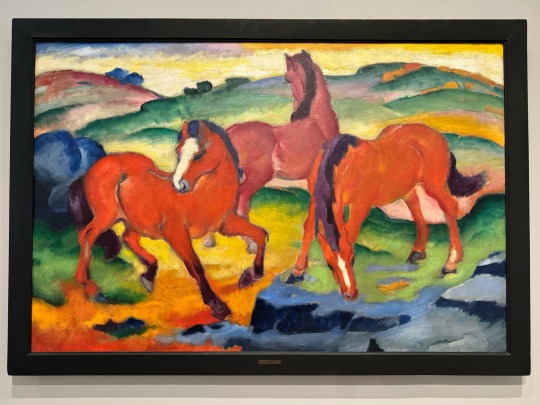
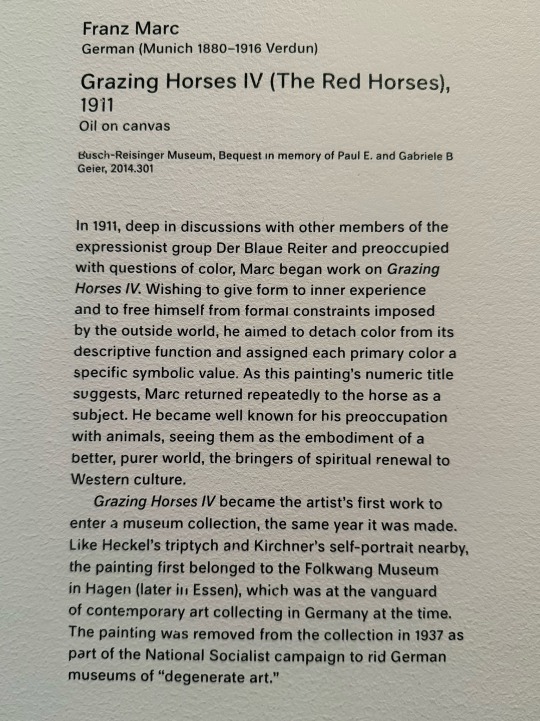
Franz Marc (German, 1880-1916)
Grazing Horses IV (The Red Horses), 1911
Oil on canvas, 121 x 183 cm (47 5/8 x 72 1/16 in.)
On display at Harvard Art Museums
“In 1911, deep in discussions with other members of the expressionist group Der Blaue Reiter and preoccupied with questions of color, Marc began work on Grazing Horses IV. Wishing to give form to inner experience and to free himself from formal constraints imposed by the outside world, he aimed to detach color from its descriptive function and assigned each primary color a specific symbolic value. As this painting's numeric title suggests, Marc returned repeatedly to the horse as a subject. He became well known for his preoccupation with animals, seeing them as the embodiment of a better, purer world, the bringers of spiritual renewal to Western culture.
Grazing Horses IV became the artist's first work to enter a museum collection, the same year it was made. Like Heckel's triptych and Kirchner's self-portrait nearby, the painting first belonged to the Folkwang Museum in Hagen (later in Essen), which was at the vanguard of contemporary art collecting in Germany at the time.
The painting was removed from the collection in 1937 as part of the National Socialist campaign to rid German museums of ‘degenerate art.’”
Bonus #BookRecommendation:
Franz Marc: Horses (2000)

#animals in art#european art#20th century art#museum visit#German art#german expressionism#der blaue reiter#Franz Marc#Harvard Art Museums#1910s#trio#Three for Thursday#painting#oil painting#horse#horses#book recommendation#Amazon Associates
29 notes
·
View notes
Note
What's your favorite art movement?
German Expressionism (1910s) specifically Die Brücke (Kirchner) and Der Blau Reiter (Kandinsky and Franz Marc)

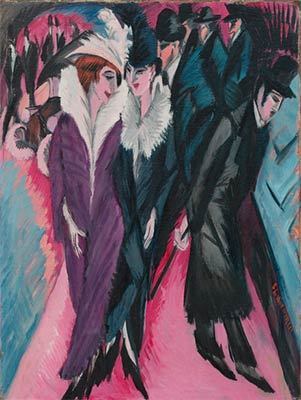
Franz Marc (Blue horse) is my favorite artist.

Kandinsky

Special shout-out to Hannah Höch, but she was more of a Dada Artist
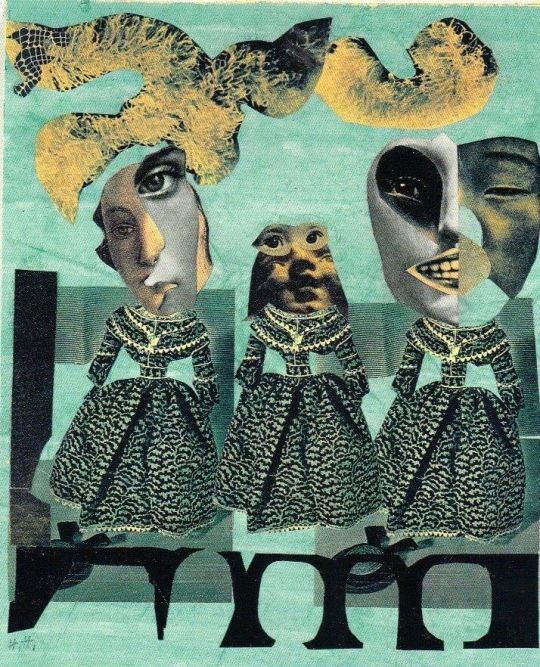

Thanks for the ask!
8 notes
·
View notes
Text
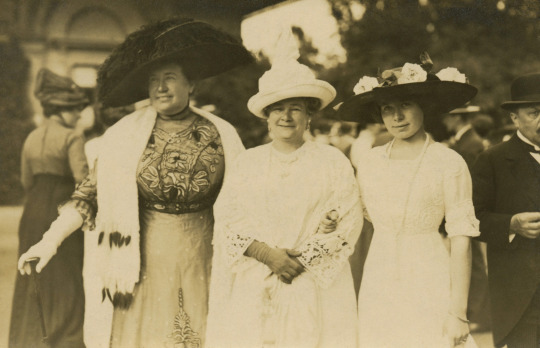

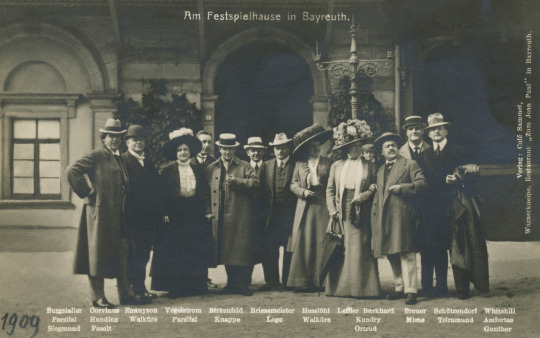

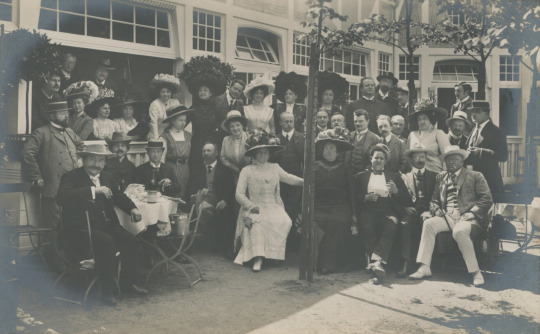
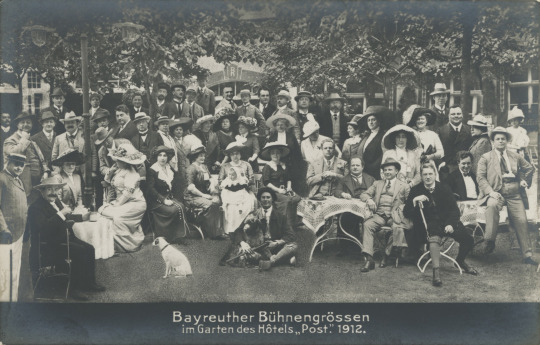

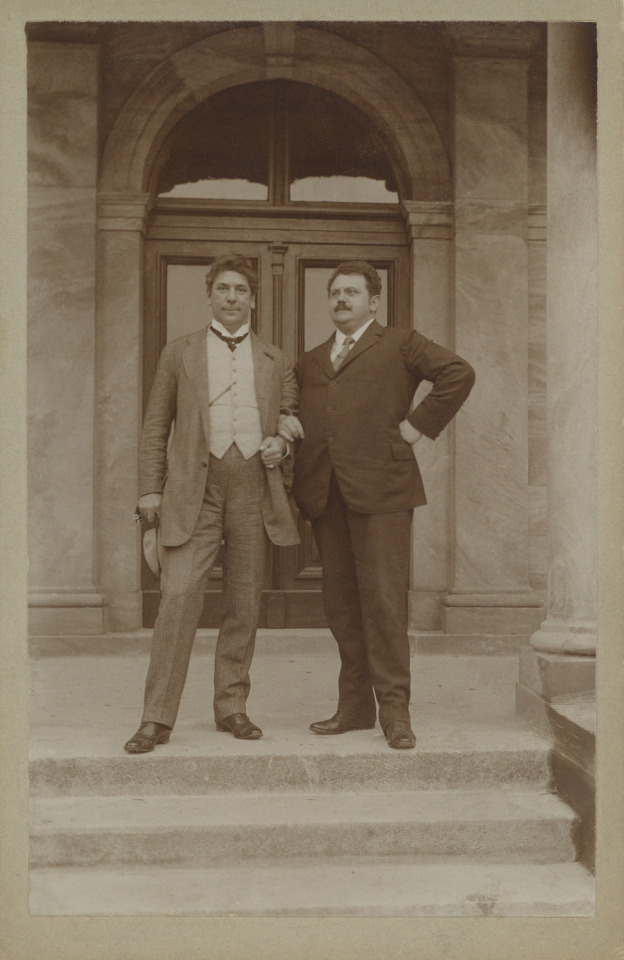

Bayreuther Bühnenfestspiele / Bayreuth Festival
THE SINGERS IN PICTURES FROM THE EARLY DAYS IN THEIR LEISURE TIME TOGETHER.
Ellen Gulbranson, Ernestine Schumann-Heink and daughter; Bayreuth, ?
Hugo Rüdel, Dr. Carl Muck, Anna Bahr-Mildenburg, Clarence Whitehill, Gertrude Rennyson, Lorenz Corvinus, Ellen Gulbranson (daughter), Hermann Bahr, Carl Braun, Fritz Vogelstrom and Marie Wittich; Bayreuth, 1906
Alois Burgstaller, Lorenz Corvinus, Gertrude Rennyson, Willy Birkenfeld, Otto Brisemeister, Emma Hesslöh, Martha Leffler-Burkhart, Hans Breuer, Alfons Schützendorf and Clarence Whitehill; Bayreuth, 1909
Karl Kittel, Hans Breuer, Alexander Kirchner, Rudolf Moest, Nikola Geisse-Winkel, Carl Braun, Ellen Gulbranson, Alois Burgstaller, Lily Hafgren-Waag, Lorenz Corvinus, Louise Reuss-Belce, Marie Wittich, Käthe Neubeck, Wilhelm Fenten and Otto Brisemeister; Bayreuth, ?
Lily Hafgren-Waag, Elsa Band-Agloda, Ellen Gulbranson, Fritz Vogelstrom, Nikola Geisse-Winkel and others (Could you identify all the singers?); Bayreuth, 1909
Ellen Gulbranson, Anna Bahr-Mildenburg, Ottilie Metzger-Lattermann and others; Bayreuth, 1912
Siegfried Wagner, ? Wieking, Ernestine Schumann-Heink, Eduard Habich, Michael Bohnen, Franz Stassen (illustrator), Prof. Khnopff (?), Hans Breuer, Winifred Wagner and others. Restaurant "Eule", Bayreuth, ?
Alois Burgstaller and Walter Soomer; Bayreuth 1897
Alois Burgstaller, Hans Breuer, Max Schlosser and Hans Schütz; Bayreuth 1896
#classical music#opera#music history#bel canto#composer#classical composer#aria#classical studies#maestro#chest voice#Bayreuther Bühnenfestspiele#Bayreuth Festival#classical musician#classical musicians#classical history#opera history#historian of music#history of music#musician#musicians#diva#prima donna
5 notes
·
View notes
Text
Kalender - Bilder unserer Landschaft 1993 der Vereins- und Westbank mit den Inhalten:
- Abendstimmung in Hamburger Hafen um 1920: Friedrich Kallmorgen
- Hamburger Hafen 1909: Albert Marquet
- Morsum Kliff auf Sylt, 1878: Eugen Gustav Dücker
- Prospekt von Schwerin über den Burgsee gesehen, 1750: Johann Alexander Thiele
- Gut Staberhof auf Fehmarn, 1913: Ernst Ludwig Kirchner
- Wiesen bei Greifswald, um 1820/22: Caspar David Friedrich
- Helgoland, 1959: Franz Radziwill
- Hiddensoe, 1922: Walter Gramatte
- Schafherde in der Lüneburger Heide, 1904: Heinrich von Zügel
- Gewitterstimmung bei Ahrenshoop, 1913: Carl Wilhelm Malchin
- Der Plöner See, 1798: Ludwig Philipp Strack
- Braunschweig, Blick vom heutigen Ruhfäutchenplatz nach Norden auf die Andreaskirche, 1832: Domenico Quaglio
- Jakobi-Kirche in Lübeck, 1958: Oskar Kokoschka
- Das Bild der Landschaft
Maße: 34 x 29
0 notes
Text
Movimientos del Siglo XX Expresionismo
En una atmósfera pre-bélica de Alemania es cuando artistas de tendencias muy diversas y diferentes formaciones se unieron para la creación de un arte más personal e intuitivo donde la “expresión” no es lo mismo que “impresión”, la primera es el ser, el sentir del artista y el segundo concepto es la mera plasmación de la realidad.
El expresionismo viene a ser una deformación de la realidad para expresarla de forma más subjetiva; Se quería mostrar sentimientos, emociones, algo que ilustre la naturaleza y el ser humano desde una perspectiva interna. Este movimiento tuvo un gran matiz pesimista y fea, ya que los expresionistas alemanes no escatimaron en mostrar lo morboso, lo prohibido y lo obsceno.
Independientemente de sus estilos, los artistas expresionistas, fueron inspirados por el trabajo de Vincent van Gogh. Emplearon paletas de colores fuertes y expresivos, trazos exagerados y deformados. Utilizando estas dos técnicas, estos fusionaban la ridiculización de esa misma sociedad con la expresión de su espiritualidad.
El expresionismo se dividió en 3 tiempos:
Pre-Expresionismo: Fuera de Alemania y antes del estallido de este movimiento aparecen artistas que comienzan a representar lo grotesco y lo extraño. Entre ellos encontramos a Edvard Munch, desde Noruega y a James Ensor, desde Bélgica. vidas llenas de sufrimiento y angustia, como dicen algunos, en países donde no salia el sol; contribuyeron al desarrollo de su creatividad con la que trataban de “diseccionar almas”.


Die Brücke: Significa “El puente” y es un movimiento que nace en 1905 como un puente hacia el futuro. Este grupo, liderado por Ernst Ludwig Kirchner, pretendió influir en la sociedad destruyendo las viejas convenciones, dejando a la inspiración fluir libre y dando expresión inmediata a las presiones emocionales del artista. Mucha crítica social, colores fuertes, temáticas desagradables y aspecto inacabado, bruto, salvaje hasta su dispersión en 1911.

Der Blaue Reiter: Surgió en Múnich en 1911, se diferencian de Die Brücke por no tener una actitud tan temperamental, más bien, una plasmación casi fisiológica de la emotividad. En vez de deformar, optaron por depurar, llegando así a la abstracción. Vasili Kandinski y Franz Marc fueron los precursores de este periodo.


0 notes
Text
German Expressionism
German Expressionism: Unveiling the Soul of the Early 20th Century
German Expressionism, a dynamic art movement that emerged in the early 20th century, is a testament to the power of inner emotions over objective reality. This movement, characterized by its bold use of simplified shapes, vivid colors, and expressive brushwork, sought to break free from the constraints of traditional representation. Instead, it delved into the depths of the human psyche, revealing a world of heightened emotions, societal critique, and existential pondering. One of the defining features of German Expressionism was its departure from the objective portrayal of reality. Artists, in their quest to express their innermost feelings, employed high angles, deep shadows, and chiaroscuro lighting to create an emotional landscape that transcended the boundaries of conventional art. This movement thrived on distorting the visual world to evoke intense moods and provoke viewers to confront their innermost thoughts. At its core, German Expressionism was driven by a desire to articulate emotional experiences and challenge the prevailing norms of art. In contrast to the detached, intellectualized art of the era, Expressionists focused on the raw and visceral. Through their works, they grappled with the complexities of modern urban life, the solace found in nature and religion, and the primal power of the human body. Their art became a means of confronting the profound changes sweeping society at the time. Expressionism in Germany was not confined to visual art; it permeated literature, theater, film, and more. It was a holistic movement that aimed to effect profound societal changes, reminding individuals of their inherent humanity. As the movement gained momentum, it extended its reach into politics, economics, social structures, publishing, music, film, and architecture, making it a cultural force that challenged the status quo. However, German Expressionism was ephemeral, existing in transition and change. Much of its output was printed on cheap paper, and as the National Socialists rose to power in Germany, Expressionism was condemned, destroying many works. Nonetheless, the legacy of German Expressionism endures as a testament to the power of art to reflect and challenge the world it inhabits. This movement continues to inspire and provoke thought, reminding us of the enduring allure of the human spirit in its rawest form.
German Expressionism Artists:
Ernst Ludwig Kirchner, a prominent figure in the Die Brücke movement, produced vibrant and emotionally charged artworks that epitomize the essence of German Expressionism. His paintings, such as “Street, Dresden,” are characterized by bold colors, jagged lines, and distorted figures, conveying a sense of urban anxiety and inner turmoil.
Franz Marc, associated with Der Blaue Reiter, explored spirituality and the connection between humans and nature in his Expressionist art. His masterpiece, “The Large Blue Horses,” is a prime example of his use of vivid, symbolic colors and abstract forms to convey a profound sense of harmony and spiritual unity.
Wassily Kandinsky, another member of Der Blaue Reiter, pushed the boundaries of artistic expression with his abstract works. His painting “Composition VII” is a symphony of colors, shapes, and lines that transcends reality, embodying the movement’s emphasis on inner experiences and emotional expression.
Egon Schiele, known for his raw and provocative art, captured the human form in a deeply expressive and often unsettling manner. His self-portraits and portraits of others, like “Portrait of Wally Neuzil,” are marked by contorted figures and intense psychological insight, reflecting the darker aspects of human existence.
Emil Nolde, a member of Die Brücke and later the Berlin Secession, brought a sense of mysticism to his Expressionist works. His painting “The Prophet” conveys a sense of spiritual ecstasy through bold colors and fluid forms, showcasing Nolde’s unique approach to the movement.
Paul Klee‘s art, influenced by Expressionism, Surrealism, and Cubism, is a testament to his innovative and whimsical style. Works like “Senecio” blend abstraction and childlike imagination, reflecting Klee’s exploration of the inner world and the fantastical.
Otto Dix is renowned for his searing critiques of German society during the Weimar Republic. His series “The War” presents a harrowing depiction of the horrors of World War I, combining graphic realism with Expressionist elements to convey the psychological trauma of war.
Käthe Kollwitz‘s emotionally charged graphic works, such as “The Mothers,” poignantly portray the human condition, particularly the suffering of women and families during times of war and hardship. Her powerful prints and sculptures exemplify the social conscience of German Expressionism.
Erich Heckel, a founding member of Die Brücke, played a pivotal role in the movement. His woodcuts and paintings, like “Roquairol,” often feature stylized, elongated figures in a raw and primitivist style, capturing the essence of urban life and human connection.
Oskar Kokoschka‘s Expressionist portraits, including “Portrait of Alma Mahler,” reveal a profound emotional intensity. His bold use of color and dynamic brushwork convey the inner turmoil and passion of his subjects, reflecting the spirit of the movement.
Max Beckmann‘s art, characterized by its dark and brooding themes, delved into the complexities of human existence. His painting “The Night” is a haunting reflection of the post-war disillusionment and moral decay, a recurrent motif in his Expressionist works.
August Macke, associated with Der Blaue Reiter, infused his works with vibrant colors and a sense of optimism. His painting “Tightrope Walker” exemplifies his playful and joyful approach to depicting life, capturing the movement’s celebration of the human spirit.
Karl Schmidt-Rottluff, a co-founder of Die Brücke, embraced the use of woodcuts and bold, angular forms. His graphic works, like “Two Men” and “Nude,” showcase his knack for distilling the essence of the subject and the emotional intensity of Expressionism.
George Grosz‘s satirical and critical approach to art is evident in works like “Eclipse of the Sun.” His sharp social commentary, often laced with dark humor, reveals the tumultuous times of Weimar Germany and the political turmoil through an Expressionist lens.
Max Pechstein‘s colorful and expressive paintings, such as “Indian and Woman,” reflect his fascination with non-Western art and cultures. His vivid use of color and flattened forms contribute to the movement’s exploration of primitivism and subjectivity.
Gabriele Münter, a key member of Der Blaue Reiter, produced vibrant landscapes and still-life paintings. Her work, like “Jawohl, Blaue Reiter,” radiates a sense of harmony and spirituality, in line with the movement’s ideals.
Alexej von Jawlensky’s portraits, characterized by their colorful abstractions and spiritual depth, are exemplified by works such as “Variation.” His exploration of the human face as a vessel of emotion and inner life aligns with Expressionism’s focus on the subjective.
Anselm Kiefer, although working in a later period, draws inspiration from German Expressionism. His monumental and layered artworks, like “Breaking of the Vessels,” grapple with history, memory, and mythology, reflecting the movement’s ongoing influence.
Georg Baselitz, known for his inverted and often provocative imagery, challenges conventions in his art. His expressive paintings, such as “Big Night Down the Drain,” confront societal norms and explore the depths of the human.
0 notes
Text
The Intersection of Expressionism in Modern Fashion and Home Wall Decoration

Introduction: Art, in its myriad forms, has always been a reflection of society’s emotions and desires. One such artistic movement that emerged during the early 20th century is Expressionism. With its bold and emotive brushstrokes, Expressionist art aimed to capture the inner complexities of human emotions. In today’s modern world, we witness how various art movements influence different aspects of our lives, including fashion and home decoration trends. This essay delves into the incorporation of Expressionism into contemporary fashion choices and explores how it has found its place in innovative frame wallpapers for TVs, monitors, homes, offices, and bars.
Expressionism in Fashion: Fashion has long been regarded as a means of self-expression. It serves as a canvas upon which individuals showcase their personalities and unique identities to the world. Drawing inspiration from Expressionist art techniques allows designers to infuse garments with vibrant colors, exaggerated silhouettes, asymmetrical shapes, and chaotic patterns.
Expressionist fashion encourages individuals to embrace their innermost feelings through clothing choices that defy societal norms. These designs often evoke strong emotional responses by challenging conventional aesthetics with avant-garde concepts. From runway shows featuring abstract prints reminiscent of Edvard Munch’s “The Scream” to garments adorned with unconventional textures emulating Ernst Ludwig Kirchner’s expressive brushwork — expressionistic influences can now be seen on global catwalks.
Home Decoration Meets Expressive Brushstrokes: The desire to create visually stimulating spaces within our homes has led interior designers to experiment with diverse artistic styles like Expressionism when it comes to home decoration trends. Embracing these abstract forms adds depth and character to living spaces while evoking emotional connections between inhabitants and their surroundings.
One notable trend inspired by Expressionism is the use of bold color palettes reminiscent of artists like Wassily Kandinsky or Franz Marc who employed vivid hues to convey intense emotions. From vibrant reds symbolizing love and passion to deep blues representing tranquility, these expressive colors find their place on walls, furniture, and decorative accents.
Another way Expressionism is manifesting in modern home decoration is through the integration of abstract forms and patterns. Furniture pieces adorned with dynamic brushstroke-like designs or wallpapers featuring distorted figures echo the unrestrained energy found within Expressionist artworks. By incorporating these elements into interior design, homeowners can imbue their spaces with a sense of artistic freedom and self-expression.
Frame Wallpaper: A New Canvas for Expressionism: The rapid advancements in technology have revolutionized how we consume media, leading to a rise in the use of televisions and monitors not just for entertainment but also as design focal points within homes, offices, and bars. To elevate the visual experience further, frame wallpapers have emerged as a popular choice for enhancing these screens’ aesthetics while paying homage to various art movements like Expressionism.
By selecting frame wallpapers inspired by Expressionist art styles, individuals can transform their screens into captivating works of art. These wallpapers often feature bold brushstrokes, exaggerated shapes reminiscent of human figures or landscapes found in famous expressionistic paintings. This fusion between technology and art allows users to immerse themselves in visually stimulating environments that go beyond mere functionality.
Conclusion: Expressionism’s influence extends far beyond traditional canvas boundaries; it has permeated contemporary fashion choices and innovative approaches to home decor seamlessly. By integrating elements from one of history’s most influential art movements into our daily lives — be it through expressive fashion statements or thoughtfully designed living spaces adorned with abstract motifs — we embrace individuality while indulging in the rich tapestry of human emotions depicted by expressionistic masterpieces. As we continue evolving creatively alongside technological advancements like frame wallpapers for TVs and monitors, let us celebrate the harmonious union between past artistic endeavours and modern trends that enhance our surroundings aesthetically while allowing us to connect with our innermost selves.
The article uses author paintings images from NikoGraph’s Etsy Shop
#modrn art#tv art#tv frame art#digital paiting#nikography#etsyseller#etsyshop#etsyart#home decor#wall art#digital painting#fine art#digitalart#samsung tv frame#4k wallpaper#wallpaper for monitor and laptop
0 notes
Text
Bekannte Künstler
Paul Klee
Ludwig Kirchner
Emil Nolde
Franz Marc
Edvard Munch
0 notes
Text

Ernst Ludwig Kirchner, portrait of Hugo Biallowons
A frequent subject in Kirchner's work, Hugo Biallowons was a dear friend of the artist who was killed in 1916 during the Battle of Verdun, the same battle which claimed the life of painter Franz Marc and countless others.
16 notes
·
View notes